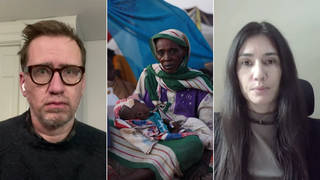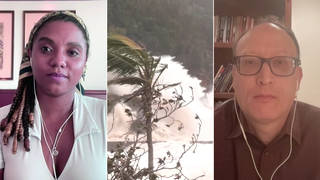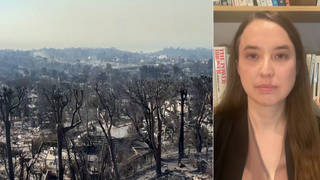
Topics
Guests
- Park Williamsbioclimatologist at Columbia University’s Lamont-Doherty Earth Observatory and lead author of a new report showing that global warming has worsened the California drought by up to 27 percent.
Scientists at the National Oceanic and Atmospheric Administration released a report Thursday showing that July was Earth’s hottest month on record. Nine of the 10 hottest months since record keeping began in 1880 have occurred since 2005. Climatologists also expect 2015 to be the hottest year on record. This news comes as scientists from Columbia University’s Lamont-Doherty Earth Observatory released a report that shows that global warming has worsened the California drought, now entering its fourth year. This new study is the first to estimate the extent to which rising temperatures are affecting the loss of moisture from plants and soil, and suggests that within a few decades continually increasing temperatures and resulting moisture losses will push California into a permanent drought by 2060. We discuss the report and the impact of the findings with the study’s lead author, Park Williams, a bioclimatologist at Columbia University’s Lamont-Doherty Earth Observatory.
Transcript
JUAN GONZÁLEZ: Scientists at the National Oceanic and Atmospheric Administration, or NOAA, released a report Thursday showing that July was Earth’s hottest month on record. Nine of the 10 hottest months since record keeping began in 1880 have occurred since 2005. Climatologists also expect 2015 to be the hottest year on record. This news comes as scientists from Columbia University’s Lamont-Doherty Earth Observatory released a report which shows that global warming has worsened the California drought, now entering its fourth year.
AMY GOODMAN: This new study is the first to estimate the extent to which rising temperatures are affecting the loss of moisture from plants and soil, and suggests that within a few decades continually increasing temperatures and resulting moisture losses will push California into a permanent drought by 2060. Joining us now to discuss the report and the impact of the findings is the study’s lead author, Park Williams. He’s a bioclimatologist at Columbia University’s Lamont-Doherty Earth Observatory.
Welcome to Democracy Now! It’s great to have you with us.
PARK WILLIAMS: Thank you very much.
AMY GOODMAN: So, lay out the main findings of your report.
PARK WILLIAMS: Sure. So I think we all know that as you warm the air, then the warmer air is able to more easily extract water from soils. We know this because a puddle on the sidewalk on a hot day will evaporate more quickly than a puddle on a cold day. And so, as we warm the atmosphere over a century, as we’ve done, that atmosphere is more able to pull water out of soils. And then, when natural climate variability causes a drought, as is happening right now in California, the drought is probably going to be worse.
But we’ve never actually put a number on that—how much worse, or how much of the California drought or of any drought is due to global warming. And what my colleagues and I did is put the number on that for the first time. We find that in the absence of global warming, the drought in California would have been somewhere between 8 and 27 percent less severe.
JUAN GONZÁLEZ: But how were you able to reach that conclusion?
PARK WILLIAMS: Well, we reached it using observed climate data. So we use monthly precipitation data, and then all of the—we use monthly data from all the variables that go into calculating evaporation. So that’s four variables: temperature, humidity, wind speed and solar radiation. And it turns out that in terms of the year-to-year variability and in terms of trends in evaporation, temperature is the most important of those four. And so, we then use very standard soil moisture modeling methods, where we basically treat California as this large network of buckets. And we use the climate data to, with precipitation, fill up the buckets, kind of like income fills up a bank account, and then we use the evaporation data to extract water from the bucket, like withdrawals from a bank account. And over time, we’re able to track how much water is in the buckets, and the changes represent changes in drought severity in California.
AMY GOODMAN: NOAA sponsored a study last year that blamed the rain deficit on what’s basically a weather-related phenomenon—what, a high-pressure ridge over the Northeast Pacific—that probably had nothing to do with global warming. Does your report contradict this?
PARK WILLIAMS: No, it doesn’t, and I’m really glad that you’re giving me an opportunity to talk about this. One of the—actually, the lead author of the NOAA study you just talked about is the second author of this study that I’ve published. And they’re two very different studies. And so, I was just talking about inputs into the water balance and withdrawals from the water balance. That study by NOAA was all about the inputs. That study found that the drought is ultimately caused by a lack of precipitation, and that lack of precipitation is ultimately caused by this really persistent, high-pressure ridge of the atmosphere that has been sitting over the Northeast Pacific Ocean and blocking storms from hitting California now for four years in a row. It’s a really abnormal event. And they find no connection with the global warming process and that ridge, or that high-pressure region.
We look at the other side of the water balance equation, the withdrawal side. And evaporation has been increasing because of warming. And so, even though climate change has not affected the precipitation—precipitation is just wildly variable in California from year to year, and so is evaporation, but underlying both of those variable things that occur naturally is this elephant in the room that’s continued to grow larger every year. And it is now—when it gets dry naturally, it is now more dry because of climate change.
JUAN GONZÁLEZ: And the economic impact on California? We’re seeing all these reports of the battles over water, obviously, exacerbated by—depending on income levels of the people experiencing it, and land sinking because of the water being drawn out from underground wells or aquifers.
PARK WILLIAMS: Well, yeah, California is seeing a lot of consequences of this drought. And all droughts have consequences. And the—presumably, it’s the kind of weakest links in the network that start showing signs of vulnerability first. And so, we have poor communities that are suffering. In some of these communities, water is no longer accessible. They relied on well water. But now the water table is too low to access water, and so water has to be shipped in some places. Land is sinking in the Southern and Central Valley, and the reason is because water has been extracted from the ground at an unsustainable pace.
AMY GOODMAN: Sinking two inches every month now in San Joaquin Valley?
PARK WILLIAMS: It’s really remarkable. And these are—from my understanding, this is part of an aquifer that was established following the last glacial period. And while it is possible to put new water into some places underground, it is no longer possible in these places where the ground has compacted, because we’ve extracted the water too quickly.
AMY GOODMAN: You also are a specialist on how climate change affects forests worldwide. Rolling Stone wrote about you in a piece.
PARK WILLIAMS: Yes, I am one of many who study that topic. And most of my work so far has been focused on the Southwest United States, which is still really relevant to California. What we found in that work is that wildfire is a direct—is a direct link to the climate system. I believe it’s part of the climate system. When you have drought, then as long as there’s fuels to burn—fuels being forests—then they will burn. And we’re seeing that in California now—we’re seeing it in Oregon and Washington, as well—because of intense drought. Now, again, this drought is caused by natural climate variability, and we’d be seeing a big fire here no matter what. But with this added impact of warming, the wildfire season is more active. And there is a secondary effect, that we have too many trees on the landscape right now. We’ve been fighting fires for a century, and that means some places haven’t had fire in a century, and there’s a lot of fuel now ready so that when a spark goes on the wrong day, we have wildfires that are far more energetic than they would be otherwise.
JUAN GONZÁLEZ: I wanted to ask you about the increasing involvement of faith leaders in the issue of climate change. Earlier this week, a group of Islamic scholars issued a call for a rapid end of the use of fossil fuels. And a couple of months ago, the pope released his groundbreaking encyclical on the environment. As a scientist, what’s your reaction to seeing now this increasing involvement of faith leaders, as a moral and religious issue the world coming to grips with climate change?
PARK WILLIAMS: Well, I think it’s encouraging. I think that the science of global warming is based purely in physics, not in faith or not in politics. And the science of how warming affects drought is also based purely in physics. And so, I’m really happy to see that leaders of any kind are letting people know, “Hey, this makes sense, and we should really be taking care of our planet.” And physics tells us that we haven’t been.
AMY GOODMAN: How do we take care of the planet? How do we reverse climate change?
PARK WILLIAMS: Well, so, this most recent work is on California, and I think California actually has a unique role in the world. When they change policy to become more efficient with their carbon use by using less gasoline, for example, then the rest of the United States is soon to follow. And when the United States makes a change, then the rest of the world is soon to follow. And so, California really has a surprisingly large ripple effect, I believe. And so, one thing we need to do globally, of course, is use fossil fuels in a sustainable way. I don’t think that that should go against anybody’s political beliefs. Just sustainable living makes sense. And digging up a nonrenewable resource and continuing to burn it 'til it's gone doesn’t.
From the drought perspective, California can do a lot more locally by using water sustainably. And there’s been a lot of, as we said, unsustainable groundwater use in California. And currently, actions are being taken to try and start regulations for groundwater extraction in California. What California tends to do, though, is, once it gets wet again, because of natural climate variability, they tend to forget that they just had a really catastrophic drought that reminded them how vulnerable they are. When it gets wet in another year or two, it’s important that California does not drop these measures that it’s beginning to make towards groundwater regulation.
JUAN GONZÁLEZ: And what are some of the other sustainable measures they could take? I mean, I’m always astounded when I—I learned a few years ago that the average golf course requires, during the hottest parts of the year, as much as 300,000-400,000 gallons of water a day.
PARK WILLIAMS: The numbers are astounding that golf courses and lawns use, although I would argue that in terms of sustainability for ground—or, I’m sorry, for water use in California or for anywhere, you really need to—the goal, I think, should be to create systems that are resilient to the worst droughts. And California, that’s very difficult to find that point, because California’s precipitation, its rainfall and snow, varies so wildly from year to year, it’s tough to remember exactly where the worst exists. But things like lawns and golf courses are actually pretty easy to—you just cut the pipe for the lawn and golf course, let it go dry, and nobody really cares. The things that are really tough, or the things that make drought effects really tough in California are things that are difficult to cut the line to. So, people in the agricultural communities, people’s livelihoods rely on agricultural, but some of our agricultural practices probably aren’t sustainable. And the fix is much more difficult.
AMY GOODMAN: Well, Park Williams, we want to thank you very much for being with us, bioclimatologist at Columbia University’s Lamont-Doherty Earth Observatory, lead author on a new report showing global warming has worsened the California drought by up to 27 percent. We’ll link to that report at democracynow.org. This is Democracy Now! We’ll be back in a minute.












Media Options